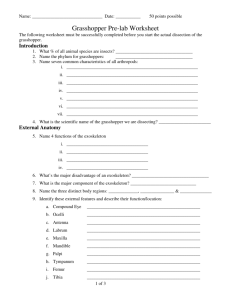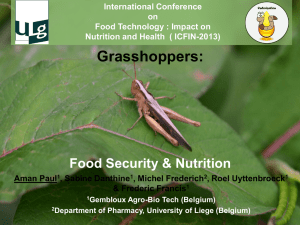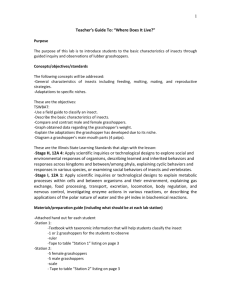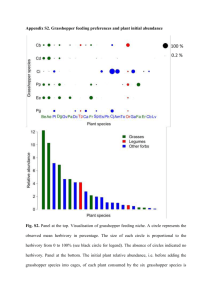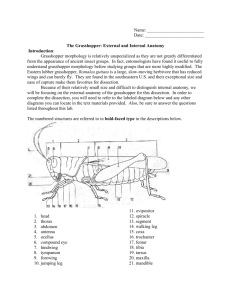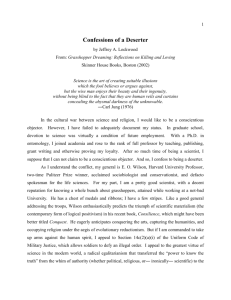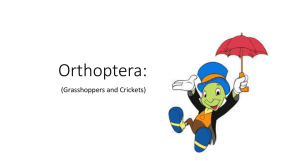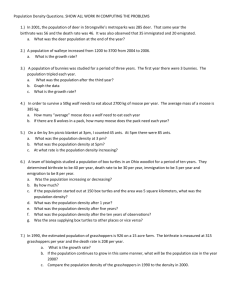Grasshoppers - Super Teacher Worksheets
advertisement
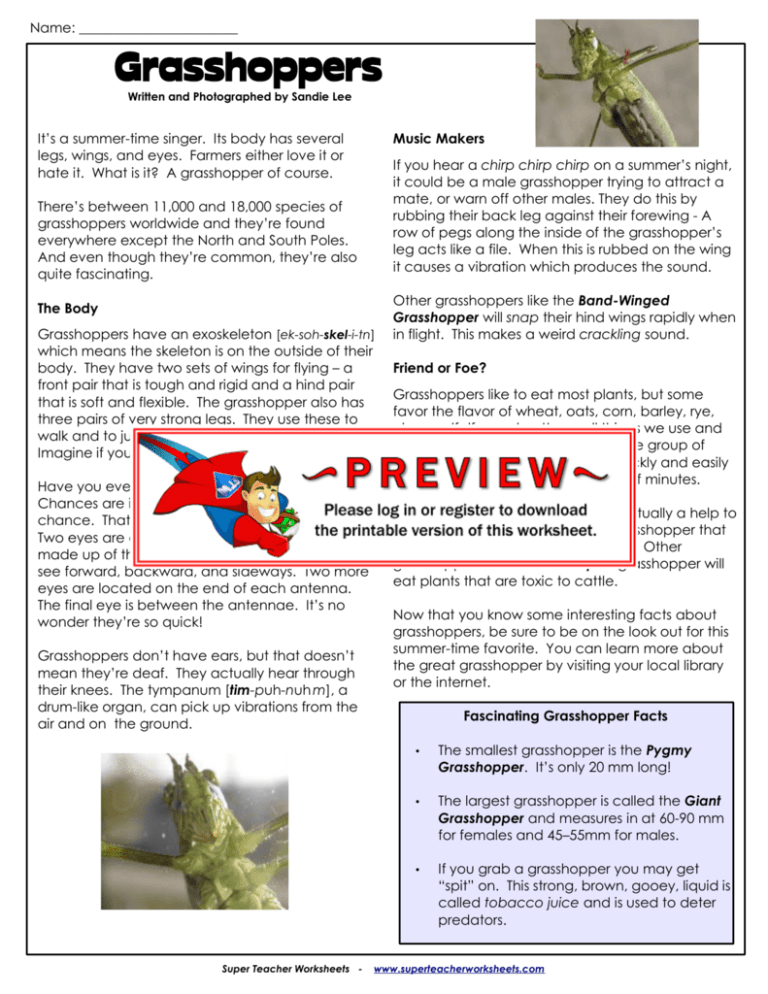
Name: _______________________ Grasshoppers Written and Photographed by Sandie Lee Music Makers It’s a summer-time singer. Its body has several legs, wings, and eyes. Farmers either love it or hate it. What is it? A grasshopper of course. If you hear a chirp chirp chirp on a summer’s night, it could be a male grasshopper trying to attract a mate, or warn off other males. They do this by rubbing their back leg against their forewing - A row of pegs along the inside of the grasshopper’s leg acts like a file. When this is rubbed on the wing it causes a vibration which produces the sound. There’s between 11,000 and 18,000 species of grasshoppers worldwide and they’re found everywhere except the North and South Poles. And even though they’re common, they’re also quite fascinating. The Body Grasshoppers have an exoskeleton [ek-soh-skel-i-tn] which means the skeleton is on the outside of their body. They have two sets of wings for flying – a front pair that is tough and rigid and a hind pair that is soft and flexible. The grasshopper also has three pairs of very strong legs. They use these to walk and to jump 20 times their own body length. Imagine if you could do that! Have you ever tried to catch a grasshopper? Chances are it bounced away before you had a chance. That’s because this insect has five eyes. Two eyes are on the front of the head. These are made up of thousands of single lenses that can see forward, backward, and sideways. Two more eyes are located on the end of each antenna. The final eye is between the antennae. It’s no wonder they’re so quick! Grasshoppers don’t have ears, but that doesn’t mean they’re deaf. They actually hear through their knees. The tympanum [tim-puh-nuh m], a drum-like organ, can pick up vibrations from the air and on the ground. Super Teacher Worksheets - Other grasshoppers like the Band-Winged Grasshopper will snap their hind wings rapidly when in flight. This makes a weird crackling sound. Friend or Foe? Grasshoppers like to eat most plants, but some favor the flavor of wheat, oats, corn, barley, rye, clover, alfalfa, and cotton – all things we use and farmers hate to loose. In fact, a large group of grasshoppers called locusts can quickly and easily devour a farmer’s crop in a matter of minutes. However, some grasshoppers are actually a help to farmers. The Turnbull is a type of grasshopper that will dine on the weeds that kill crops. Other grasshoppers like the Two-Striped grasshopper will eat plants that are toxic to cattle. Now that you know some interesting facts about grasshoppers, be sure to be on the look out for this summer-time favorite. You can learn more about the great grasshopper by visiting your local library or the internet. Fascinating Grasshopper Facts • The smallest grasshopper is the Pygmy Grasshopper. It’s only 20 mm long! • The largest grasshopper is called the Giant Grasshopper and measures in at 60-90 mm for females and 45–55mm for males. • If you grab a grasshopper you may get “spit” on. This strong, brown, gooey, liquid is called tobacco juice and is used to deter predators. www.superteacherworksheets.com Name: _______________________ Grasshoppers Written and Photographed by Sandie Lee 1. Circle the best answers to these questions. a. How many wings does a grasshopper have? 2 4 6 8 10 b. How many eyes does a grasshopper have? 1 3 5 7 9 c. About how long are the world's largest grasshoppers? 2. 20mm 55mm 90mm Grasshoppers do not have ears, yet they can hear. Explain. _____________________________________________________________________________________________ _____________________________________________________________________________________________ 3. How does a grasshopper make a chirping sound? a. It rubs two legs together. b. It rubs one of its legs along one of its wings. c. It rubs its wings together. d. It rubs its back leg against one of its its antennae. 4. Why do farmers sometimes dislike grasshoppers? _____________________________________________________________________________________________ _____________________________________________________________________________________________ 5. Why do farmers sometimes like grasshoppers? _____________________________________________________________________________________________ _____________________________________________________________________________________________ Super Teacher Worksheets - www.superteacherworksheets.com Name: _______________________ Grasshoppers Vocabulary Activity Step 1: Re-read the article, “Grasshoppers.” As you read, use a highlighter or yellow crayon to highlight each of the vocabulary words from the box. Step 2: exoskeleton organ vibration foe barley toxic Match each vocabulary word with its definition. 1. ________ exoskeleton a. enemy 2. ________ organ b. poisonous; dangerous to eat or drink 3. ________ vibration c. movement of molecules that makes a sound 4. ________ foe d. body part made of cell tissue 5. ________ barley e. hard covering on the outside of an animal's body 6. ________ toxic f. type of grain used to make cereal and other food products Step 3: Complete each sentences with the correct vocabulary word. 7. You shouldn't eat those berries because they might be ____________________________. 8. After the storm, the farmer's ____________________________ field was flooded. 9. When his brother turned up the music in the car, Joey could feel ____________________________ in the seat. 10. The liver is the heaviest ____________________________ in the human body. Super Teacher Worksheets - www.superteacherworksheets.com ANSWER KEY Grasshoppers Written and Photographed by Sandie Lee 1. Circle the best answers to these questions. a. How many wings does a grasshopper have? 2 4 6 8 10 b. How many eyes does a grasshopper have? 1 3 5 7 9 c. About how long are the world's largest grasshoppers? 2. 20mm 55mm 90mm Grasshoppers do not have ears, yet they can hear. Explain. Grasshoppers have a tympanum, a drum-like organ, in their knees that senses vibrations. 3. How does a grasshopper make a chirping sound? b a. It rubs two legs together. b. It rubs one of its legs along one of its wings. c. It rubs its wings together. d. It rubs its back leg against one of its its antennae. 4. Why do farmers sometimes dislike grasshoppers? Grasshoppers eat their crops. 5. Why do farmers sometimes like grasshoppers? Some types of grasshoppers eat the weeds that kill crops. Super Teacher Worksheets - www.superteacherworksheets.com Name: _______________________ Grasshoppers Vocabulary Activity Step 1: Re-read the article, “Grasshoppers.” As you read, use a highlighter or yellow crayon to highlight each of the vocabulary words from the box. Step 2: exoskeleton organ vibration foe barley toxic Match each vocabulary word with its definition. 1. e exoskeleton a. enemy 2. d organ b. poisonous; dangerous to eat or drink 3. c vibration c. movement of molecules that makes a sound 4. a foe d. body part made of cell tissue 5. f barley e. hard covering on the outside of an animal's body 6. b toxic f. type of grain used to make cereal and other food products Step 3: Complete each sentences with the correct vocabulary word. 7. You shouldn't eat those berries because they might be toxic. 8. After the storm, the farmer's barley field was flooded. 9. When his brother turned up the music in the car, Joey could feel vibrations in the seat. 10. The liver is the heaviest organ in the human body. Super Teacher Worksheets - www.superteacherworksheets.com
